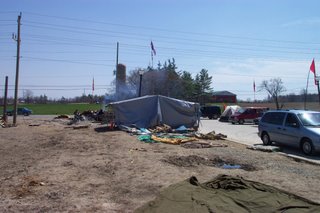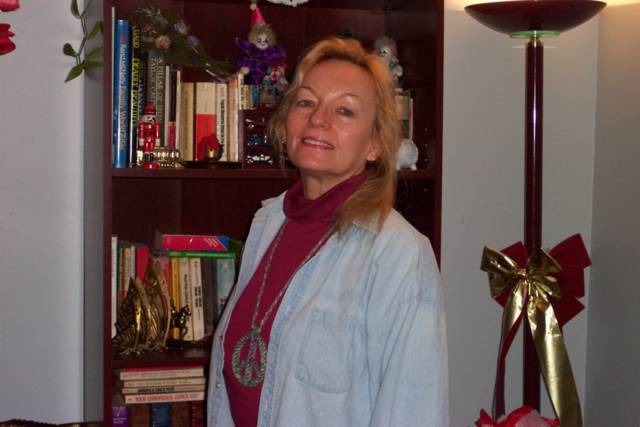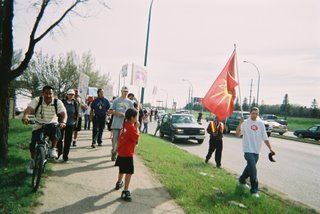(204) 427-2312 FAX:
(204) 427-2584
More Dangerous Than Oka
April 25, 2006
The potential flashpoint at Caledonia Ontario with the Six Nations land blockade is more dangerous than the 1990 Oka crisis.
In 1990 the town of Oka, Quebec, wanted to expand their nine hole golf course to eighteen holes over a known Mohawk gravesite. A police officer died to defend the right of the townspeople to tee off over grandma’s grave and 4,000 Canadian soldiers squared off against the Mohawks.
In 1990 most Canadian Indians were in shock that Canada would use the army against our people. In 2006 there is no longer any shock value, thereby allowing Indian people to be better prepared to respond to bloodshed and also Indian youth in Canada have more anger today than they did in 1990. Not only are Indian people better prepared, the strategy is much clearer.
Had then Canadian Prime Minister Brian Mulroney carried out his threat to send in the army to take out the last 25 barricaded Mohawks regardless of the consequences, it was very likely that burning cars would have blocked every railway line in Canada.
The protest at Caledonia has already caused a railway blockade with huge economic impact. Multiple that one railway blockade by 30 and you have economic paralysis in all of Canada.
Canada is America’s largest trading partner and of vital economic interest to every American. Canada is America’s largest supplier of oil with 97 per cent of all Canadian energy exported to the United States. Canada is also the leading buyer of American exports. Think about the Mayan uprising of 1994, multiply that by 10 and you have some idea of the economic impact of a similar crisis in Canada. American multi-national corporations, financed in the open market, with heavy investment in Canada, may not yet have realized the danger.
The difference in treatment of indigenous people between Canada and United States is shocking. In the United States, American Indians proudly fly the American flag in every Indian reservation. Thirteen thousand American Indians currently serve in the US military, and 2,000 of those are serving on the front lines in Iraq.
Thousands of American Indians are millionaires, hundreds are multi-millionaires. Attend a National Indian Gaming Association summit, and you will see proud American Indians talking and making multi-million dollar deals. You will see trade shows that would be the envy of many countries. Not so in Canada.
You would be hard pressed to find a Canadian flag flying on an Indian reservation. You would be more likely to find a Mohawk warrior society flag in the window of native homes. With well over 50 per cent of the Canadian Indian population under the age of 25, what you have in Caledonia is a potential flashpoint that could cripple Canada.
Canada has had eight straight federal government budget surpluses. It has a 2005 reported net worth of $4.5 trillion, and a GDP well over a trillion dollars.
In 2003 the federal government raised $125 billion in taxes but took in $141.8 billion in its share of resource royalties. This does not include the provincial royalties or corporate resource sales profits. With oil now over $75 a barrel, up from $10 a barrel in 1999, and Canada claiming 1.4 trillion barrels of oil in the Alberta tar sands plus hundreds of other oil and gas producing areas, this makes for a resource driven economy.
As the third largest producer of diamonds, with 10 per cent of the world forests, and over 60 metals and minerals, there is little doubt why Indian land claims are a big issue in Canada. The fact that there are over 6,000 land claims in limbo and that progress is so slow is not surprising given the numbers and the revenue generated for government coffers.
Canada was the United Nations choice as the “best country in the world to live in” for seven straight years, but while Canada was number one on the index, Canadian First Nations communities mired in extreme poverty were set at the 63rd level on the UN scale.
Amnesty International has written several reports citing Canada for human rights violations. In the case of the Lubicons of northern Alberta, Amnesty has forced the appearance of Canada before the United Nations for a hearing set for May 5th.
While Canada can laugh off the United Nations and weather international shame, E it cannot ignore or laugh off the economics of a national blockade of rail lines that is potentially the result of the land dispute at Caledonia.
To understand the issue of land claims in Canada, one must see the numbers. Canada is the second largest country in the world, larger than China and larger than the United States. Canada is 3.83 million square miles of vast land mass, but the population is only 33 million, giving Canada the largest per capita land base of any nation in the world. Given the resource base, it is little wonder that net worth is $137,000 per man, woman, and child.
In 1969, Canada issued the appropriately named “white paper” on Indians, which identified that Indian reservation lands accounted for approximately one quarter of one per cent of the Canadian land mass. To state this more clearly, 99.73 per cent of Canada was not reservation lands. Since then it has been a battle zone of land claims and frustration for indigenous people.
In the United States where Indian land claims are also contentious items, and where the population density is almost ten times higher than Canada, American Indian reservation lands accounted for 2.13 per cent of the United States land mass. Today that percentage has improved due to Casino generated revenue used to buy back land plus Casino revenue generated court cases and political lobbying that settled some long standing problems.
This is not to say that everything is perfect in US and American Indian relations but at least there is hope. It has been widely reported that American Indians spend more money to get Senators and Congress men elected than even Enron did its heyday. The lack of similar hope for change in Canada is what could trigger a crisis.
How Canadian media handles the situation at Caledonia can make or break the confrontation. In the Ipperwash situation where unarmed native activist Dudley George was killed by an Ontario Provincial Police officer and the Premier of Ontario allegedly shouting to “get the fucking Indians out”, the issue of land claims couldn’t be clearer. Stoney Point First Nation lost land to Canada during WWII for an artillery range, with the promise to return the land after the war.
In over 50 years of Liberal and Conservative federal governments, none delivered on that commitment. Hence, there was direct action by Ojibway Indians to occupy the land, with the resulting killing of Dudley George. The same court injunctions issued by white courts and the public outcry to march the police and army into battle are now occurring in Caledonia.
As an elected Chief, I stand behind Mohawk people at Six Nations in the use of direct action regardless of the consequences. My community spent hundreds of thousands of dollars trying to settle a land claim from 103 years ago; we hold the record of the longest file in the Indian Claims Commission process. We understand the need for direct action.
Elected native leadership risk their creditability in Caledonia. It is the people who suffer the housing crisis, the 80 per cent average unemployment, the health problems, the lack of educational opportunities, and every other form of extreme poverty while we as chiefs are paid for our work from government of Canada dollars.
To issue a call to our people not to attend the blockade and to question their right to protest is nonsense. To blame our unarmed people for the increase in tension is absolutely ridiculous.
It has always been the whites who first bring guns and the threat of violence into any confrontation. To declare that Dudley George got himself killed because he grew tired of ineffectual politicians is historically incorrect.
Hope is the only medicine for angry youth who see no other way but to take action. If it takes a national blockade to bring the world’s attention to the issues in Canada, we should be prepared to take that responsibility.
We must end the 80 per cent average unemployment in our communities. It is no longer enough to make empty promises, or to take the word of a government that will only delay settlement of long standing issues.
Now is the time we must stand together and take whatever consequences are necessary to ensure a chance for our future generations, in this, one of the wealthiest nations in the world. It is time to force Canada to the table and negotiate some real settlements of land claims instead of holding out for more false hope promises while we collect our pay from the government.
Chief Terrance Nelson
Message from Chief Terrance
Nelson, elected chief of Roseau
River Anishinabe First Nation,
spokesman for Anishinabe
Warrior Society and Board of
Director for American Indian
Movement
 With Janie Jamieson
With Janie Jamieson Road into the Henco construction site
Road into the Henco construction site Smoke in background is from the Sacred Fire
Smoke in background is from the Sacred Fire A Tepee
A Tepee View from the field
View from the field My son and I in front of the supply hut
My son and I in front of the supply hut










